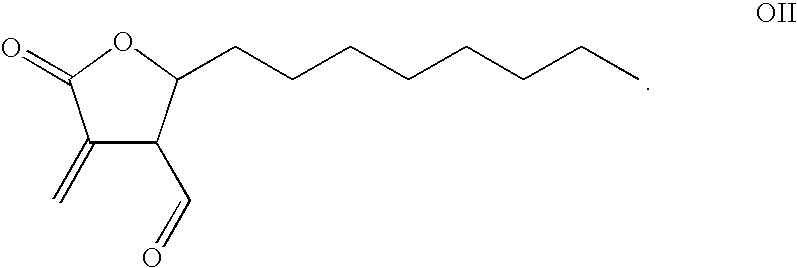Combination Product of Receptor Tyrosine Kinase Inhibitor and Fatty Acid Synthase Inhibitor for Treating Cancer
a technology of receptor tyrosine kinase and fatty acid synthase, which is applied in the direction of peptides, drug compositions, peptides, etc., can solve the problems of dramatic weight loss and inhibition of feeding, and achieve the effects of reducing fasn activity, reducing fasn expression, and inhibiting fasn activity
- Summary
- Abstract
- Description
- Claims
- Application Information
AI Technical Summary
Benefits of technology
Problems solved by technology
Method used
Image
Examples
example 1
[0067]Effect of FAS and ErbB inhibition on A2780 ovarian cancer cells (OCC). A FASN inhibitor (C75) and an irreversible ErbB inhibitor (EKB-569,4-Dimethylamino-but-2-enoic acid [4-(3-chloro-4-fluoro-phenylamino)-3-cyano-7-ethoxy-quinolin-6-yl]-amide) inhibit growth of OCC (MTT assay—IC50: C75=22 μM; EKB-569=5, 1 μM). A dose-dependent reduction of in-vitro cell growth of A2780 ovarian cancer cells by a combination of a synthetic FASN inhibitor (C75) and of an ErbB inhibitor (EKB-569) as demonstrated by formazan dye assay, as shown in FIG. 1. Cells were grown for three days in the presence of vehicle (0.1% DMSO) or synthetic inhibitor before cell number was estimated. Data in the charts represent means + / −SD of triplicate measurements. Table 1 shows the concentrations of each individual inhibitor required for 50% reduction of cell growth (IC50-values, means + / −SD of 3 to 5 independent experiments).
TABLE 1IC50-values for a combination product(C75 + EKB-569) in OCC study.IC50 (μM)DrugMe...
example 2
[0076]The effect of FASN and ErbB inhibition on both A2780 and SKOV3 ovarian cancer cells was examined. Concurrently contacting the cells with both a FASN inhibitor (C75), given concurrently with an ErbB inhibitory agent such as pelitinib (EKB-569), canertinib (CI-1033), erlotinib, cetuximab, matuzumab or trastuzumab, sensitizes the cells against each of the ErbB-targeting agents (p<0.01) suggesting cooperation between FASN and ErbB pathways in ovarian cancer. qRT-PCR and Western blotting revealed that C75 represses FASN mRNA and protein, and impairs EGFR, ErbB2 and AKT expression and activity, which is consistent with the notion that FASN-induced lipid rafts accommodate and stabilize ErbBs and facilitate recruitment and activation of AKT. Activated AKT negatively crosstalks with ERK and stimulates EGFR and FASN, respectively, thus feeding an autostimulatory loop, which further boosts FASN and EGFR transcription. On the other hand, pharmacologic (pelitinib, canertinib, erlotinib) or...
PUM
| Property | Measurement | Unit |
|---|---|---|
| Fraction | aaaaa | aaaaa |
| Composition | aaaaa | aaaaa |
| Acidity | aaaaa | aaaaa |
Abstract
Description
Claims
Application Information
 Login to View More
Login to View More - R&D
- Intellectual Property
- Life Sciences
- Materials
- Tech Scout
- Unparalleled Data Quality
- Higher Quality Content
- 60% Fewer Hallucinations
Browse by: Latest US Patents, China's latest patents, Technical Efficacy Thesaurus, Application Domain, Technology Topic, Popular Technical Reports.
© 2025 PatSnap. All rights reserved.Legal|Privacy policy|Modern Slavery Act Transparency Statement|Sitemap|About US| Contact US: help@patsnap.com



